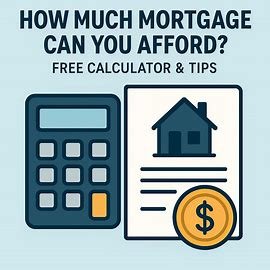
Buying a home is an exciting milestone, but before you start house hunting, you need to answer one important question: How much mortgage can you afford? Understanding your affordability will save you from financial stress and help you make a confident purchase decision. This comprehensive guide explains everything you need to know, including affordability factors, a free mortgage calculator, and practical tips to stay within budget.
Section 1: Understanding Mortgage Affordability
What Does Mortgage Affordability Mean?
Mortgage affordability refers to the maximum loan amount you can borrow without compromising your financial stability. It takes into account your income, monthly expenses, debts, and other financial obligations. Lenders use certain ratios to determine affordability, but you should also consider your personal comfort level with monthly payments.
Buying beyond your means can lead to financial strain and even foreclosure. Therefore, it’s crucial to analyze not just what the lender approves, but what you can realistically manage.
Why is Affordability Important?
Knowing your affordability before applying for a mortgage prevents overspending and helps you set a realistic budget. It also:
- Speeds up the home-buying process.
- Reduces the risk of mortgage default.
- Allows you to plan for other life goals, such as education, travel, or retirement.
A well-calculated affordability range will ensure long-term financial security while allowing you to enjoy homeownership stress-free.
Section 2: Key Factors That Determine How Much Mortgage You Can Afford
Income and Debt-to-Income Ratio (DTI)
Your income is the foundation of mortgage affordability. Lenders assess your DTI ratio, which compares your total monthly debt payments to your gross monthly income. The general rule is that your DTI should not exceed 43%, although lower is better.
Example Calculation: If your monthly income is $6,000 and your total monthly debt payments (including the mortgage) are $2,400, your DTI ratio is:
Credit Score and Interest Rates
Your credit score directly impacts the interest rate you receive. Higher credit scores typically qualify for lower interest rates, which means lower monthly payments and higher affordability.
Key Ranges:
- Excellent: 760+
- Good: 700-759
- Fair: 650-699
- Poor: Below 649
Down Payment and Loan Term
A larger down payment reduces the loan amount, thereby lowering monthly payments. Similarly, the loan term (15 years vs. 30 years) affects affordability: shorter terms mean higher payments but less interest overall.
Other Costs to Consider
Affordability isn’t just about principal and interest. You should also account for:
- Property taxes
- Homeowner’s insurance
- Private mortgage insurance (PMI) if down payment < 20%
- Maintenance and utilities
Example Table: Additional Costs
| Expense Type | Average Monthly Cost |
|---|---|
| Property Taxes | $200-$500 |
| Insurance | $50-$150 |
| Maintenance | $100-$300 |
Section 3: How to Calculate How Much Mortgage You Can Afford
Using the 28/36 Rule
One popular guideline is the 28/36 rule:
- 28% of your gross income for housing costs (mortgage, taxes, insurance).
- 36% of your gross income for all debts (including housing).
Example: If your monthly income is $6,000:
- 28% of $6,000 = $1,680 (housing budget)
- 36% of $6,000 = $2,160 (total debt limit)
Free Mortgage Affordability Calculator
To make things easy, use a free mortgage calculator. Input your:
- Income
- Down payment
- Interest rate
- Loan term
- Estimated taxes and insurance
The calculator will show you the estimated monthly payment and maximum affordable loan amount.
Example Calculation:
- Income: $6,000
- Down Payment: $40,000
- Interest Rate: 6%
- Loan Term: 30 years
Estimated monthly payment: $1,600 (including taxes and insurance)
Adjusting for Comfort
While these rules help, personal comfort matters. If you prefer saving more for vacations or retirement, choose a home that keeps payments well below the maximum limit.
Section 4: Practical Tips to Improve Mortgage Affordability
Increase Your Down Payment
Saving for a larger down payment reduces your loan amount, lowering both monthly payments and interest paid over time. Consider:
- Cutting discretionary expenses.
- Using bonuses or tax refunds for savings.
- Exploring down payment assistance programs.
Improve Your Credit Score
A better credit score means better rates. Tips to boost your score:
- Pay bills on time.
- Reduce credit card balances.
- Avoid new credit inquiries before applying.
Reduce Debt Before Applying
Lowering your existing debts improves your DTI ratio, making you more attractive to lenders. Pay off high-interest loans first and avoid new obligations.
Shop for the Best Mortgage Rates
Different lenders offer different rates. Compare multiple offers and consider points, fees, and closing costs in addition to interest rates.
Section 5: Common Mistakes to Avoid When Determining Mortgage Affordability
Ignoring Additional Costs
Many buyers focus solely on the principal and interest, forgetting about taxes, insurance, and maintenance. These can add hundreds of dollars monthly.
Maxing Out Your Budget
Just because a lender approves a high amount doesn’t mean you should borrow it all. Leave room in your budget for emergencies and future financial goals.
Overlooking Lifestyle Needs
If you love traveling, dining out, or saving aggressively for retirement, consider these expenses when setting your mortgage budget.
Not Considering Future Changes
Think about job stability, potential family growth, or moving plans. A mortgage is a long-term commitment; plan for flexibility.
Conclusion: Find Your Perfect Balance
Determining how much mortgage you can afford is about balancing lender requirements with your financial comfort. Use the guidelines, free calculator, and tips provided in this guide to make an informed decision. Ready to calculate your affordability? Try our free calculator now and share your results in the comments! Have questions? Ask below, and let’s make your home-buying journey smooth and stress-free.